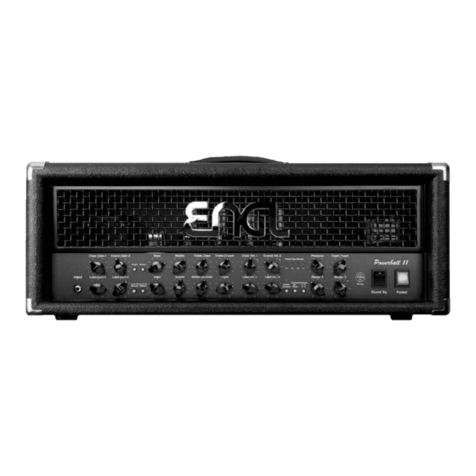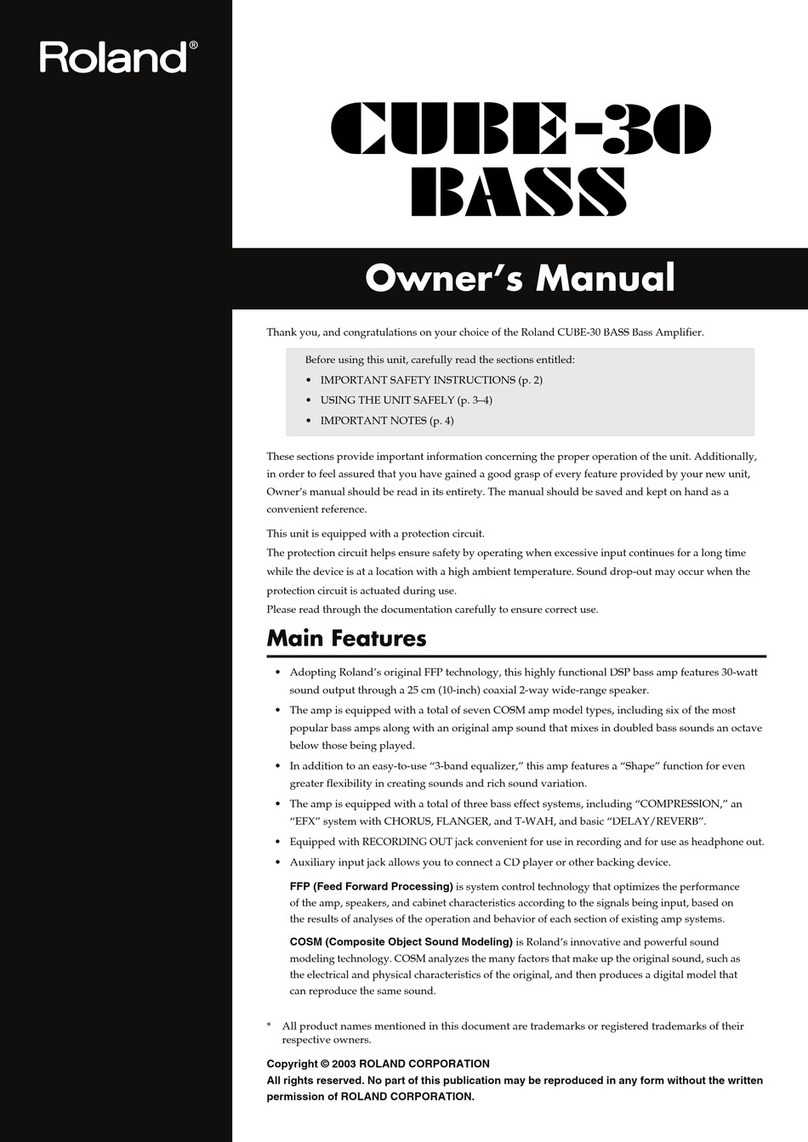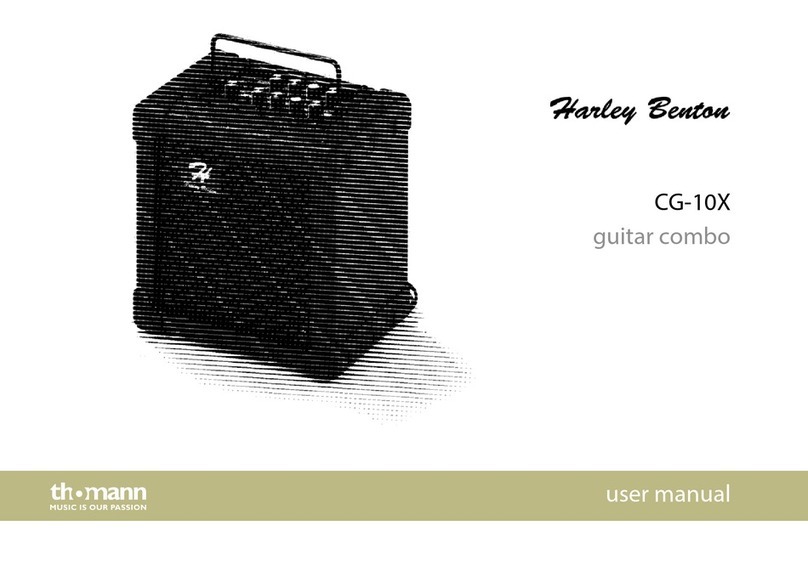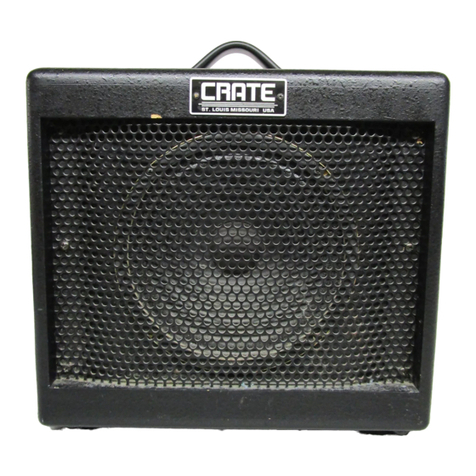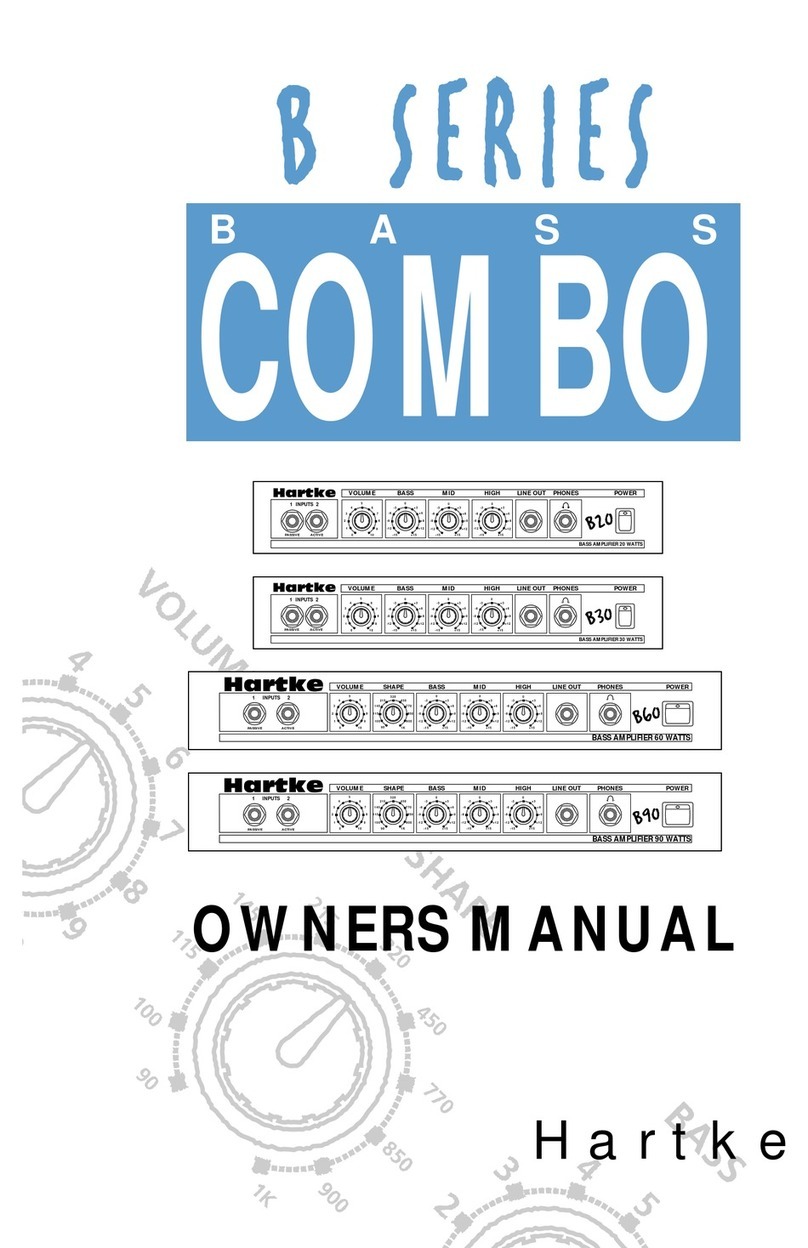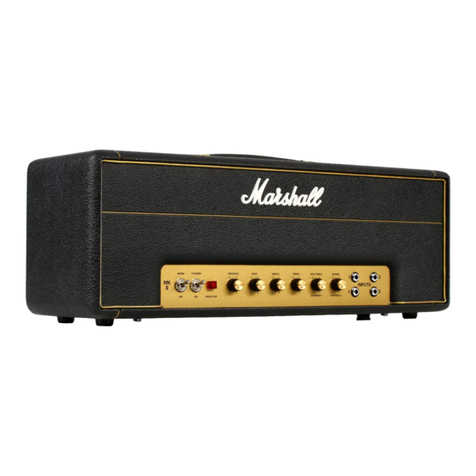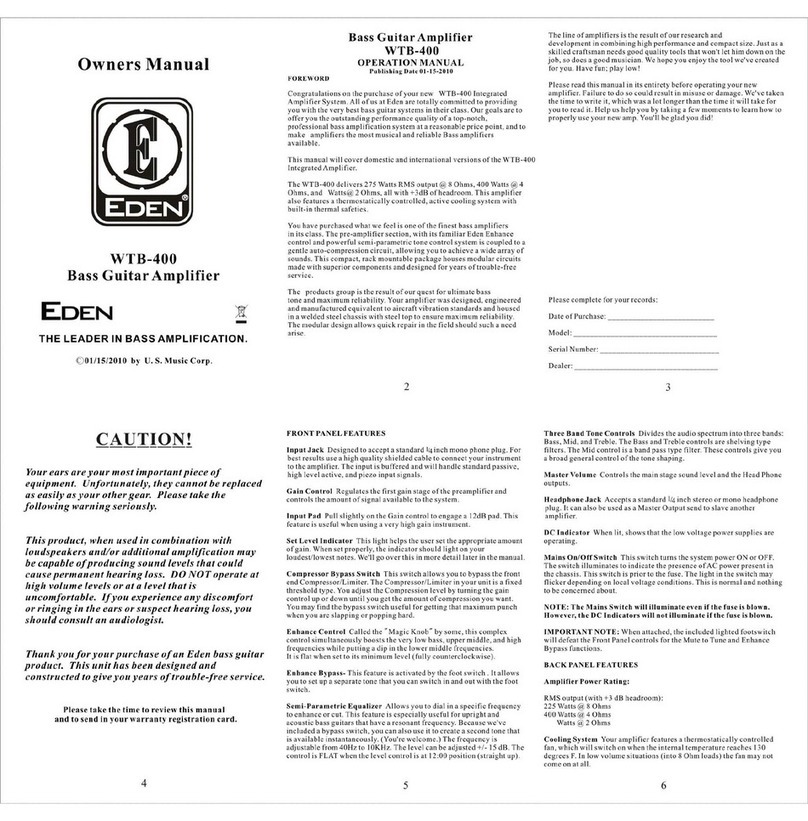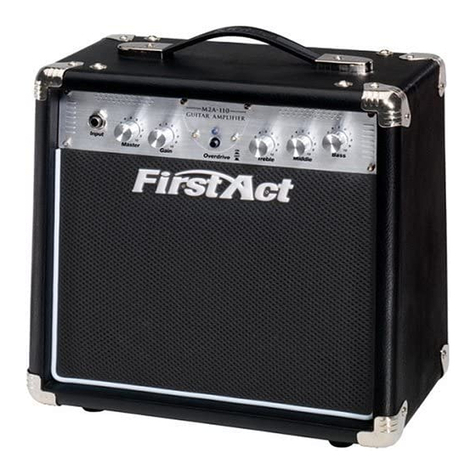George Dennis The Blue BASSIC TUBE 120 User manual

George Dennis The Blue™
BASSIC TUBE™120 and BASSIC TUBE™200 bass amplifiers
Reference and Over´s Manual
Congratulations on your purchase of a George Dennis Blue Line Amplifier. All our amps have been subjected
to all necessary mandatory tests required by both American and European norms and have passed in all
areas.
George Dennis is proud to introduce on the world market two brand new models of all –tube bass
amplifiers, this time using the standard E 34 L (120 W RMS ) and a hand –made, high precision KT88
( 200 W RMS ) tubes.
Bassic Tube 120 –120 W and Bassic Tube 200.
Both models feature identical control configuration. Extra emphasis is being placed on offering the player a
full range of tonal choices, consequently resulting in accommodation of all playing styles while in the same
time highlighting the outstanding attributes of each individual instrument used. To meet the highest
standards in terms of both the best quality of a bass amp and highest expectations of accomplished
players, our amps are being made of the very best components available. There is no signal distortion even if
you turn both the Gain and Master Juice controls all the way to maximum. Alternately, when you play the
amp quietly you can still feel its hidden potential while retaining unaltered tonal properties. The footswitch
FSB 2 switches both the entire MIDDLE section and WARM function ON or OFF. At the peak the Bassic
Tube 120 will deliver as much as 230 W and the Bassic Tube 200 as much as 300 W. Tube amps are
generally much more dynamic than the transistor ones, hence the impression of more power. Both of these
amps boast beautifully warm and clear sound and differ only by incorporation of different power units, power
tubes and transformers. However, the preamps in both models are tuned in identical way.
Our philosophy as a prime source of guidance during development and construction of this bass
amp, broken down to four main objectives.
1. Obtain the desired sound when using any type or make of an electric bass guitar.
2. Attain high sound level without jeopardizing dynamic properties.
3. Create sufficient power, dynamics and sound color in reserve, especially in the bass and sub bass
frequencies.
4. Enable the player to use the control configuration creatively, maximizing his/her chance of arriving at
that personal sound.
Bassic Tube™120 –3x12AX7 a 4x E 34 L, 120 W RMS, parallel stereo FX Loop, direct out, output for
tuner and pre amp out.
Bassic Tube™200 –3x 12AX7 a 4x KT-88 (hand made), 200 W RMS, parallel stereo FX loop, direct out,
output for tuner and pre amp out.
.
Operating your amp.
Operating the Bassic Tube is very simple. You have one channel. Gain –signal intensity in the preamp and
Master Juice ( slang for Master Volume ) –power gain in the power end. Furthermore, you have the pot
HEAT which is actually gain number two and enables you to emphasize the sound core as well as control
elements of tonal coloring, described in the layout of the front and back panel. Do not overlook the + 6 dB
switch, which enables you to boost the sound level at a flick of a finger.

-2-
We recommend using George Dennis speaker cabinets. These bass cabinets utilize special Celestion
loudspeakers and guarantee clear sound projection. Moreover, these cabinets are made of 13 –ply birch
plywood and are fitted inside with vertical sound wave breakers and padding. Cabinets come in three
versions:
GD115B, 300 W RMS, 1 x 15“ + Tweeter or GD 115BS (small version)
GD410B, 600 W RMS, 4 x 10“ + Tweeter
GD210B, 300 W RMS, 2 x 15“ + Tweeter
Tweeter can be switched off at will. Connecting jacks are 2 Neutrik Speakon.
Points about BIAS.
Our apms use power tubes which are always paired in selected quartets. BIAS varies in each individual
manufacturer of tubes, resulting in a different overall sound of an amp. We therefore recommend that a BIAS
tune up will be performed by a qualified technician. The BIAS tuning trim pot is located inside the chassis on
the main printed circuit board. !!! Never remove chassis with the power ON !!! The preamp uses 3 pcs of 12
AX 7 ( ECC 83 or 7025 ) which can be changed by the player without worrying about BIAS.
How do you begin.
1. Prior to using the amp first check the correct voltage selection on the back panel ( USA, Canada, Japan
115 V, Europe and Britain 230 V ). Fuses should be selected according to the instruction on the back panel.
2. Plug the power cord into a wall socket and connect the footswitch via supplied connecting cable
Jack-Jack to Footswitch on the back panel. Turn the Master Juice knob to a position 0 and switch the
POWER switch on the front panel to a position ON. Wait approx. 1 –2 minutes and switch the STANDBY
switch to the position ON. Your amp is now ready to be used.
3. The control knob WARM plus the entire MIDDLE control section can be switched ON and OFF at will by
the footswitch, which comes with every amp. However, to ensure a proper function of footswitch the control
switches on the front panel must be in position MIDDLE OFF and the one switching WARM in the position
NORMAL.
4. To begin creating your sound we recommend you turn all the knobs on the front panel to position 5 and
the switches to position left or 1. As you proceed experimenting, don’t be afraid to use the extreme
positions of the knobs. Let your personal taste, not the knob positions, be the guide.
BASSIC TUBE 120 and 200 -front panel controls.
From left:
INPUT HI –input for instruments not equipped with active electronics
INPUT LO –input for instruments with active electronics
+6 dB –in the position ON you obtain a 6 dB boost in input sensitivity in both inputs
GAIN –preamp signal saturation control
BRIGHT –boost of high frequencies in preamp
HEAT –creation of warmer and gutsier sound
WARM –switch placed after frequency controls, helps to obtain more saturated sound
BALLS –more gain while bass frequencies are being more pronounced
CHOICE –two types of sound color in bass frequencies
BASS –bass frequencies control
INPUT
LO
HI
Bright
Normal
Warm
STANDBY
George Dennis Ltd.
MUTE
Choice
On POWER
FILTERSOff
Choice Bright
ON
ON
ON
MASTER
JUICE
GAIN MIDDLEHEAT BALLS BASS TREBLE
Choice
OFF
OFF
Fine
Soft
Extreme
+ 6 dB OFF
On
OFF ON
OFF ON
OFF ON I II I II III

OFF-ON –to switch the entire MIDDLE section ON or OFF
-3-
CHOICE –two types of sound color in mid frequencies
MIDDLE –mid frequencies control
FILTERS –three mid –frequency settings, can be combined according to taste
TREBLE –high frequencies control
CHOICE –two types of sound color in high frequencies
MASTER JUICE –overall volume level control of the amp
BRIGHT –an option to widen the high frequency range in the power amp
MUTE –in the position ON the amp is entirely mute while the preamp out, tuner out and send/return remain
fully functional
STANDBY –after having switched the POWER switch ON, wait 2 minutes and switch this switch to the
position ON
POWER –main power switch ( initial tube heating )
BASSIC TUBE 120 a 200 –back panel functions
From left:
MAINS –voltage selector 115/230 V. Before switching the amp ON, always check the appropriate
voltage of the country you are in.
MAINS FUSE –power voltage fuse –must be chosen correctly.
H.T. FUSE –anode voltage fuse, same for all countries and must be chosen correctly .
SPEAKER OUTPUT –external speaker 4, 8 Ohm
D.I.OUT –balanced output for a mixing console. Does not include speaker simulator.
TUNER OUTPUT –jack for an instrument tuner.
PRE-AMP OUTPUT –can be connected to another power and slave.
FOOT PEDAL –Jack for connecting footswitch cable. Both footswitch an connecting cable come with
the amp.
FX LOOP BLEND –a pot controlling the ratio between direct and effect signal.
RETURN –here you plug in a cable leading from output jack of an effect unit.
SEND –here you plug in a cable leading from an input of an effect unit.
Foot switch pedal.
Footswitch pedal is connected to the amp via a stereo shielded cable fitted on both ends with a stereo jack.
In case of cable or footswitch pedal switch malfunction the cable should be replaced by a new one and the
stereo jacks should be soldered on while observing the wiring in the original.
MAINS
FOOTSWITCH

-4-
Caution ! In order to engage the footswitch properly, the switches on the front panel must be in the position
MIDDLE OFF and in position NORMAL pertaining to WARM.
Troubleshooting procedures.
!!! When replacing fuses the power cord MUST NOT be connected to a power wall socket !!!
In case of amp malfunction try the following steps:
1. The LED in the POWER switch does not come on. A) power cord is not plugged in power wall socket.
B) there is no power in the wall socket
C) the MAINS fuse is blown.
2. the POWER switch lights up but there is no sound. A) check if the speaker box is connected to the
amp
B) turn the MASTER JUICE and GAIN to the position 3
C) turn all frequency pods to at least position 3
3. hum can be heard but no sound. A) check if your guitar is connected to the amp and the volume knob
on the guitar is at least half way up.
B) disconnect all effect pedals
C) check the guitar cord or use a new one
If your amplifier still does not function, please see your authorized George Dennis technician.
GEORGE DENNIS Bassic Tube 120 a 200 SPECIFIKACE
Type: BASSIC TUBE 120 BASSIC TUBE 200
Power output RMS: 120 W 200 W
Power Requirements: 115/230V AC, 50/60Hz 115/230V AC, 50/60Hz
600W 600W
Effects Send/Return Impedance: 100 ? / 1 M? 100 ? / 1 M?
D.I. OUT: Max. 1,5 V RMS, 1 kHz, 600 Ohm –for both units (depending on the input signal)
Tubes: 3x ECC83, 4x E34L 3x ECC83, 4x KT88
Fuse Mains: T5A/250V pro 100-120V T,5,5A/250V pro 100-120V
version, T2,8A/250V pro version, T2,8A/250V pro
230-240V version. 230-240V version.
Fuse H.T.: T 1,5 A T 1,5 A
Foot switch: 2 Button switch Controls, MIDDLE SECTION OFF/ON, WARM OFF/ON
Dimensions: Height: 26 cm 26 cm
Width: 28 cm 28 cm
Depth: 57 cm 57 cm
Weight: 30 kg 31 kg
ELECTRICAL CONNECTIONS AND SUPPLY
WARNING: This appliance must be earthed. Please check that the supply voltage details given on the rating
label ( located on the rear panel ) are in accordance with your electricity supply.
FITTED PLUG: This appliance is supplied with a fitted plug. If the socket outlets in the home are not
suitable for the plug supplied with this appliance ( or the plug becomes damaged and requires replacement
), it should be cut off and an appropriate three-pin plug fitted as detailed later this in section.
IMPORTANT: A moulded plug severed from the mains lead must be destroyed immediately. Such a plug
with a bared flexible cord is hazardous if a live socket outlet.
FUSE: If the fuse of the moulded on plug is to he replaced, remove the coloured fuse cover on the underside
of the plug, and use a suitably certified 5A fuse approved by ASTA to B51362, i.e.-, the fuse carries the
ASTA mark. The fuse cover must always be replaced. Never use the plug cover omitted. Replacement fuse
covers are available from your local authorised service agent.

FITTING A PLUG: As the colours of the wires in the mains lead of this appliance may not correspond with
the coloured markings identifying the terminals in your plug, proceed as follows:
-5-
The wire which is coloured green and yellow must be connected to the terminal in the plug which is marked
with the letter ,E, or by the earth symbol or coloured green and yellow.
The wire which is coloured blue must be connected to the terminal in the plug which is marked with the
letter ,N, or is coloured black.
The wire which is coloured brown must be connected to the terminal in the plug which is marked with the
letter ,L, or coloured red.
Note that when fitting a plug, if the wires are tinned, the tinning must be removed and the connections made
to clean copper wire.
If a 13A (BS1363) plug is used, a 3A fuse must be fitted. If any other type of plug is used, a 3A fuse must
be fitted.
WARNING: If, after you have followed the instruction outlined above, your amplifier fails to function, please
contact your local distributor. Under no circumstances remove the rear panel of the amplifier while it is
connected to the power supply.
Electrical appliances must never be used where there is a danger of water splashing or dripping onto the
unit. Your attention is drawn to the instructions printed on the notice attached to the back of the amplifier. A
exposure to extremely high noise levels may cause a permanent hearing loss. Individuals vary considerably
to noise induced hearing loss but nearly everyone will lose some hearing if exposed to sufficiently intense
noise for a sufficient time.
WARNING: TO REDUCE THE RISK OF FIRE OR ELECTRIC SHOCK, DO NOT EXPOSE THIS
EQUIPMENT TO RAIN OR MOISTURE.
NO USER SERVICEABLE PARTS INSIDE, REFER SERVICING TO QUALIFIED
PERSONNEL ONLY.
THE UNIT MUST BE EARTH GROUNDED !!
THESE BASS AMPLIFIERS HAVE BEEN TESTED AND FULLY COMPLY WITH
CE THE FOLLOWING NORMS:
UL EN55013(A12):1995 , EN55020:1995, EN55103:1995 , EN61000-3-2:1995 ,
ULC EN61000-3-3:1995 , EN60065:1995, UL 6500, E-65
LV 72/23/EEC , EMC 89/336/EEC ,

This manual suits for next models
1
Table of contents
Other George Dennis The Blue Musical Instrument Amplifier manuals
Popular Musical Instrument Amplifier manuals by other brands

GLOCKENKLANG
GLOCKENKLANG Blue Bird user manual

Peavey
Peavey Triple 40/EFX owner's manual
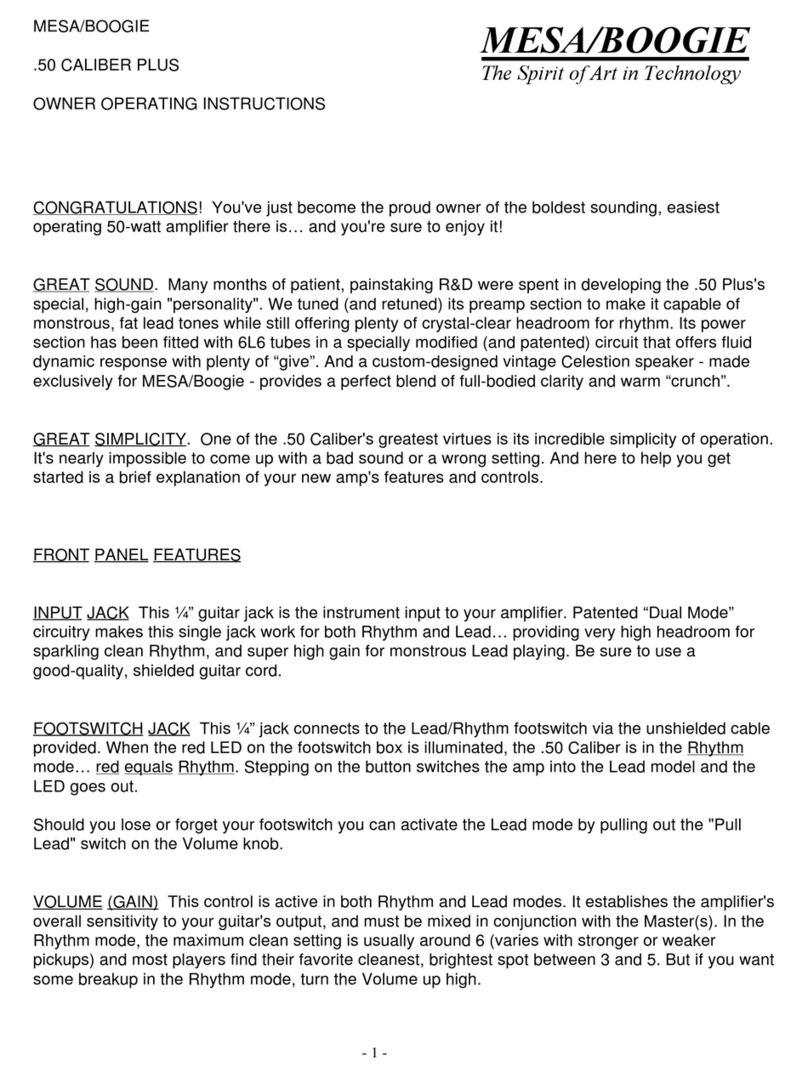
Mesa/Boogie
Mesa/Boogie Three Channel Dual & Triple Rectifier Solo... Owner operating instructions
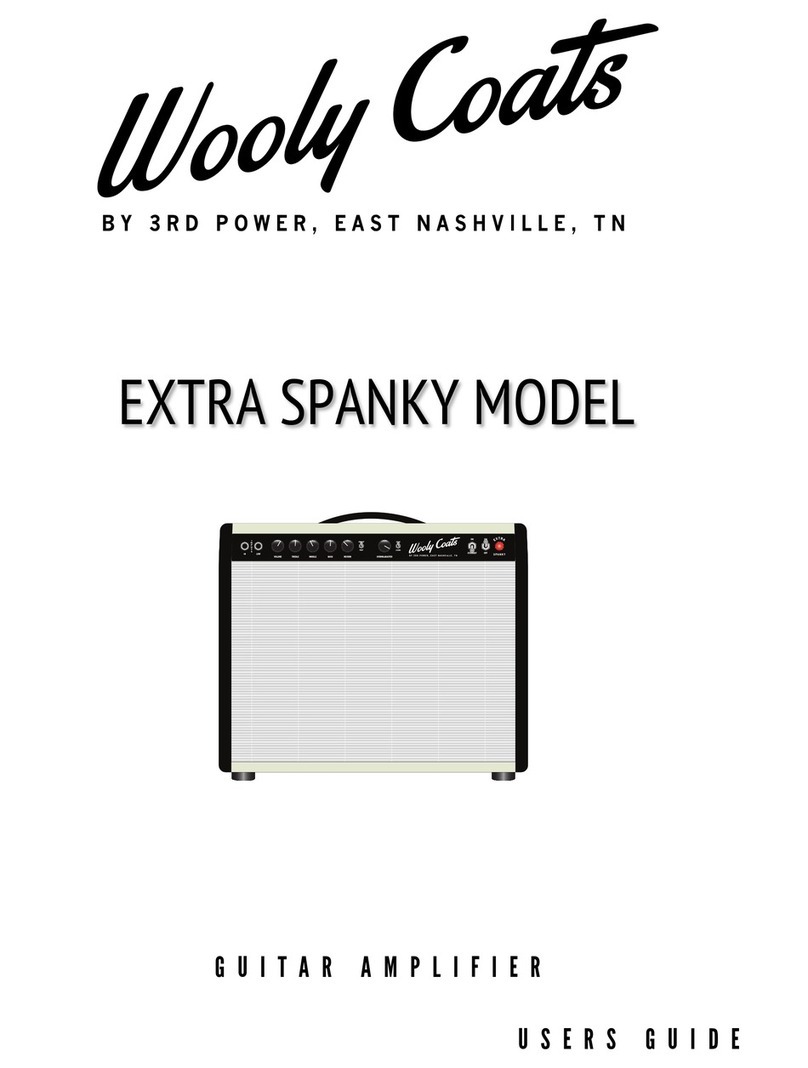
3rd Power
3rd Power WOOLY COATS EXTRA SPANKY user guide

Peavey
Peavey Mark III Bass operating guide
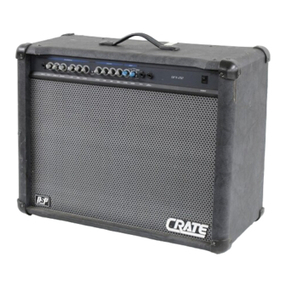
Crate
Crate GFX-120/212 owner's manual

